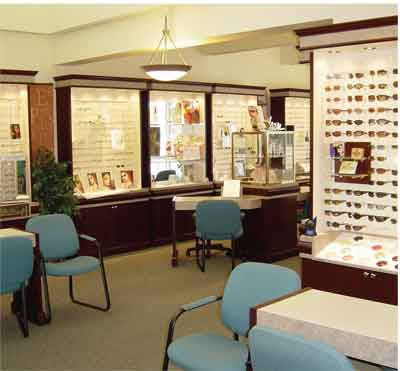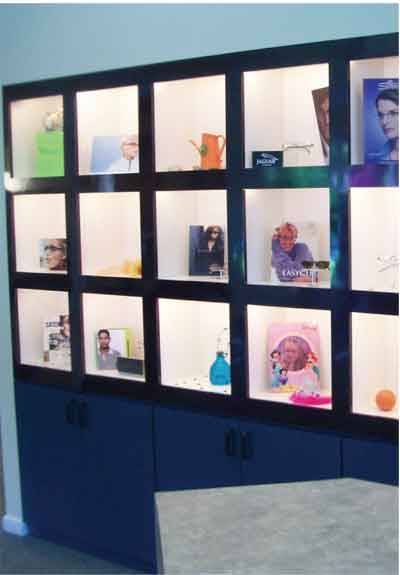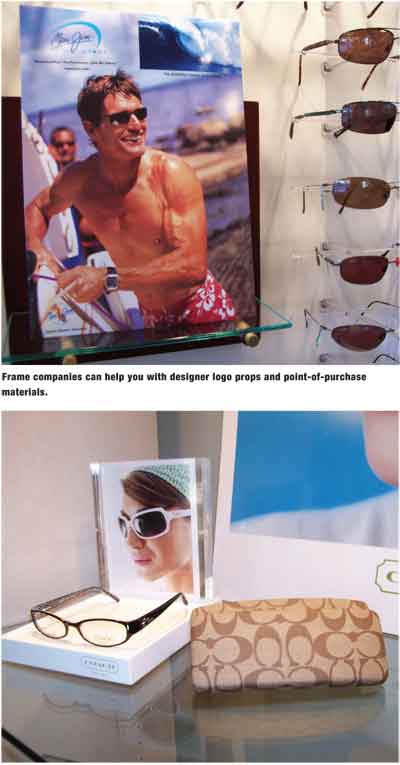Your dispensary can offer your patients something outside opticals do not: a personal touch. Because you and your staff know each of your patients, you can provide them with the perfect eyewear to fit their individual needs.
Even so, many of you may find yourself unable to retain many of your patients prescriptions. This cannot only shortchange your patients but your practice as well, as I have found that about 50% of an optometrists revenue comes from his or her dispensary.
The following are five ways you can ensure that your patients fill their prescriptions with you.
1. Know the Numbers
You cant improve your number of in-house prescriptions if you dont know what this number is. So, the best place to start is to determine how many Rxes you write and how many your optical fills.
If you use electronic medical records software, you may be able to gather the data automatically, and simply generate a report. If you use paper records, try this system:
Have your optical department track every job it orders (or makes in-house) each month. Do this on your computer or in a paper notebook log. The log should indicate whether each job was from an in-office Rx or an outside doctor.
Write all new spectacle Rxes on two-part no carbon required (NCR) paper. If a patient takes his or her Rx elsewhere, give the patient the top copy, and drop the second in a central collection box. At the end of each month, tally the Rx-to-go copies.
Handle duplicate Rxes or safety Rxes deemed not true walk-outs with a different style Rx blank. Do not count these Rxes.
This system tells you the total Rxes written by your office; the total Rxes retained (both the number filled and percentage of all Rxes written) and the total Rxes that came into your optical from outside providers.
View the Rxes that you fill from outside practitioners as a bonus that compensates you for some of the Rxes that walk-out. In other words, if you wrote 200 Rxes one month, filled 160 of those and filled 20 Rxes from outside practitioners, you filled 180 Rxesa retention rate of 90%.
2. Earn Trust and Loyalty
Gimmicks and sales pressure may actually send a message that your practice should not be trusted. So, avoid these, and build relationships with your patients instead.
The reception and examination process offers a wonderful opportunity to earn patient trust and loyalty. Treat your patients with sincere respect, show that you genuinely care about them, and be fair in every way.
My philosophy: Help your patient as if he or she were a member of your family, and make sure your staff follows these same principles.
Trust and loyalty are intangible and difficult to measure, but youll generally know when youve achieved them. Patient loyalty is the highest degree of customer satisfaction. It results in wonderful practice building power by encouraging patients to return and refer others.
|
|
| The physical appearance of your dispensary is a big part of Rx retention. When the patient walks into your optical, he or she should immediately think, Im in the right place to buy glasses!" |
3. Offer a Great-Looking Optical Facility
The physical appearance of your dispensary is a big part of Rx retention. When the patient walks into your optical, he or she should immediately think, Im in the right place to buy glasses! The confidence earned during the examination process is cemented in a glance of your beautiful optical furnishings, displays and inventory.
Here are some tips on how to make your dispensary dazzle:
|
|
| Make your optical visible from the reception area. This encourages patients to browse while they are waiting to see you. |
 |
| Great opticals start at about 1,000 square feet of space in which you put enough display furniture and dispensing tables in place. That may mean that your entire office must be larger. |
 |
| Have at least 600 frames on display (as many as 2,000 in a large office). Also, have at least 10% additional units as understock to replace frames taken off the displays each day. Displays must always remain full to present that freshly stocked appearance. |
There are two schools of thought on frame stock: One is to base the frame total on the number of inventory turns you have per year, which is based on current sales figures. However, I look toward a projected number of Rxes retained; I want an impressive look even if my retention rate is poor. An impressive look will help you retain more Rxes, as people want choices.
 |
|
Keep your displays up-to-date and aesthetically pleasing. |
 |
Perhaps an employee who has good taste and a flair for design would be interested in taking on your dispensarys look. Also, consider hiring an interior designer for a one-time session to improve the dispensarys look and give your staff an example to work from.
Consider adding high-tech features, such as virtual try-on camera systems and patient education software that explains eye conditions and lens options. These devices make your office look cutting edge, and theyre fun for patients to use. Print photos of your patients wearing their new glasses (with your office logo in the corner) so that when the patient shows the photo to her friends and family, theyll see that your practice has the latest and greatest equipment.
Balance indirect fluorescent lighting with incandescent lighting. Fluorescent lighting is the standard in commercial office space, but its a drawback for an optical dispensary. Skin tones look terrible; if your patients dont like how they look, they will search for more flattering spectacles elsewhere.
So, although you may need some fluorescent lighting to make light levels bright enough (indirect fluorescent lighting is better), add incandescent lights to balance this lighting. Recessed cans and attractive semi-flush fixtures work well.
Track lighting is fine to highlight products and displays, but make sure the lights do not directly shine on your patients, as this can be very annoying to them. Also, be sure to replace outdated styles of lighting.
Some optometrists fear that a beautiful dispensary will scare off patients, because patients will think that a fancy dispensary means high prices. However, many patients who walk with their Rxes go di-rectly to the mall and seek the larg-est, most fancy optical chain store they can find.
Although some patients may go elsewhere looking for low-priced frames and accessories, others go to large chain opticals, where the prices may be the same or higher than your dispensary. Patients want choices, and they want to buy their spectacles in a place that looks as though it does optical in a big way. Consider having an in-office lab. Patients also want a fast turnaround time, which the mall opticals and large chains offer. An in-office optical lab will enable you to have faster delivery of the product, higher quality, fewer disappointments and more options available to correct mistakes.
4. Provide Legendary Service
Examine everything you do from the patients point of view. Make your policies as patient-friendly as possible. Practices generally are hurt much more by tough policies than they are by giving in to patient requests.
For instance, if a patient returns to your practice and says he is unhappy with the appearance of the lenses in his frames, correct that complaint quickly and happily by remaking his glasses. This creates a loyal patient who will want to obtain his eyewear from you in the future and who will refer others.
Observe your staff with a critical eye. Are they truly friendly and happy to see each patient who stops in for an adjustment or repair? Do they recognize returning patients and refer to them by name? (Referring to patients by name makes them feel important and highly valued, and it builds a personal relationship.) Is your staff interested in providing excellent service?
Changing staff attitudes can be a difficult process, but it begins with examining office culture and improving communication. Meet with your employees to discuss this Rx retention initiative, and discuss the importance of excellent patient service.
5. Ease the Transition
The transfer of the patient who needs spectacles to your optician is a very important step in the patients care and one that can help you retain Rxes. Here is one way to ensure a smooth transition:
Discuss the patients vision status with him or her while the patient is in your chair. Recommend specific optical products that you feel will best meet the patients needs. This may include frame type, progressive lenses, anti-reflective coatings, second pairs, etc. To initiate this discussion, ask questions about the patients lifestyle.
Refrain from giving menus or options of products; just recommend the best product for the patient first. Also, dont bore the patient with too much technical jargon.
You might feel averse to initiating this conversation for fear of looking like a salesperson. However, by discussing a patients visual needs and offering him or her the best product(s) to meet those needs, you encourage patients to value and trust your expertise. This, in turn, should help you retain Rxes and generate word-of-mouth referrals.
Page your optician, or escort the patient to the dispensary. Introduce the patient to your optician or technician, and summarize your recommendations for the optician. Consider using a written lens option form that you fill out while with the patient in the exam room.
Your optician can continue the educational process by reinforcing your recommendations, offering additional options and suggesting sunglasses and occupational glasses that you may not have discussed with him while he was in the exam room.
Another approach: In my practice, a technician completes the pre-testing and then acts as a scribe during the exam. When I discuss the patients visual needs, the tech listens, takes notes and is drawn into the discussion.
The technician then escorts the patient to the optical and completes the dispensing. This option saves significant time, as you do not need to wait for an optician.
While these five steps will enable you to retain a majority of your patients and ensure they are getting the best and most appropriate eyewear for both their visual and life-style needs, be sure to walk a respectable line between inviting patients to stay and preventing them from leaving with their prescriptions.
Remember, the law requires that you give your patients their prescriptions. And by doing this, you not only show your patients you respect their right to choose where to fill their Rxes, but that you are not afraid of what the other opticals have to offer. After all, you offer your patients your own unique personal touch, your expertise as a doctor and a large inventory of stylish frames and accessories.
Dr. Gailmard is in group private practice in Munster, Ind., and he is president of Gailmard Consulting.



